
Email Deliverability: Avoiding The Spam Folder [2025]
Imagine putting in all of the time, effort, and money just for your emails to land in the recipient’s spam folders. If an email ends up in the junk folder, then did it ever even exist?
In this guide, we’re going to deep dive into email deliverability and we’re going to show you how to keep your emails away from the dreaded spam folder.

The easiest and most affordable email marketing and newsletter software!
First, the facts:
What is Email Deliverability?
Email deliverability measures how successful the placement of your marketing emails are in your recipients’ inbox folder.
Maintaining good email deliverability would mean that all of your emails are sent and delivered. Bad email deliverability means that something alerted a spam filter and sent that email directly to the spam folders.
How To Maximize Email Deliverability
Click on the tabs on the interactive table below to quickly scan through the factors that can affect your email deliverability:
- Be Consistent With Your Volume
- Keep Your Lists Clean To Crush Bounce Rate
- Spam Complaints = Death For Your List
- Steer Clear Of Spam Traps
- Whatever You Do, Don’t Get Blacklisted!
- Use SPF To Verify Your Sender IP
- Use DKIM To Verify Ownership Of An Email Message
- Encrypt Your Email (Using TLS) To Build Trust With Users And Mailbox Providers
- High Volume Sender? Opt For A Dedicated IP Address
- Time-Sensitive Campaigns? You Need A Dedicated Email Address
- Shared IPs For Everyone Else
- Monitor Mailbox Provider Feedback Loops
- Setup (And Monitor) An Abuse Reporting Mailbox
- Setup MX Records For Your Sender Domain
- Send Relevant Content That Your Subscribers Want To Read
- Looks Matter: Be Consistent With Your Design
- Mobile-Friendly Designs Are No Longer Optional
- Be Careful With URL Shorteners
- Don’t Send Spammy Subject Lines Or Content
- Don’t Use Free, Personal Email Addresses For Your Campaigns
- Always Include A Plain Text Version Of Your Campaigns, Along With The HTML Version
- Pay Attention To Image/Text Ratio (But Don’t Sweat It Too Much)
- Use Double (Rather Than Single) Opt-In For Your Lists
- Segment Campaigns To Give Your Subscribers EXACTLY What They Want
- Make It Easy To Unsubscribe (Seriously)
- Don’t Use A “No-Reply” Sender Address
The Email Deliverability Infographic by Moosend
We have put together all the factors affecting email deliverability in a handy infographic.
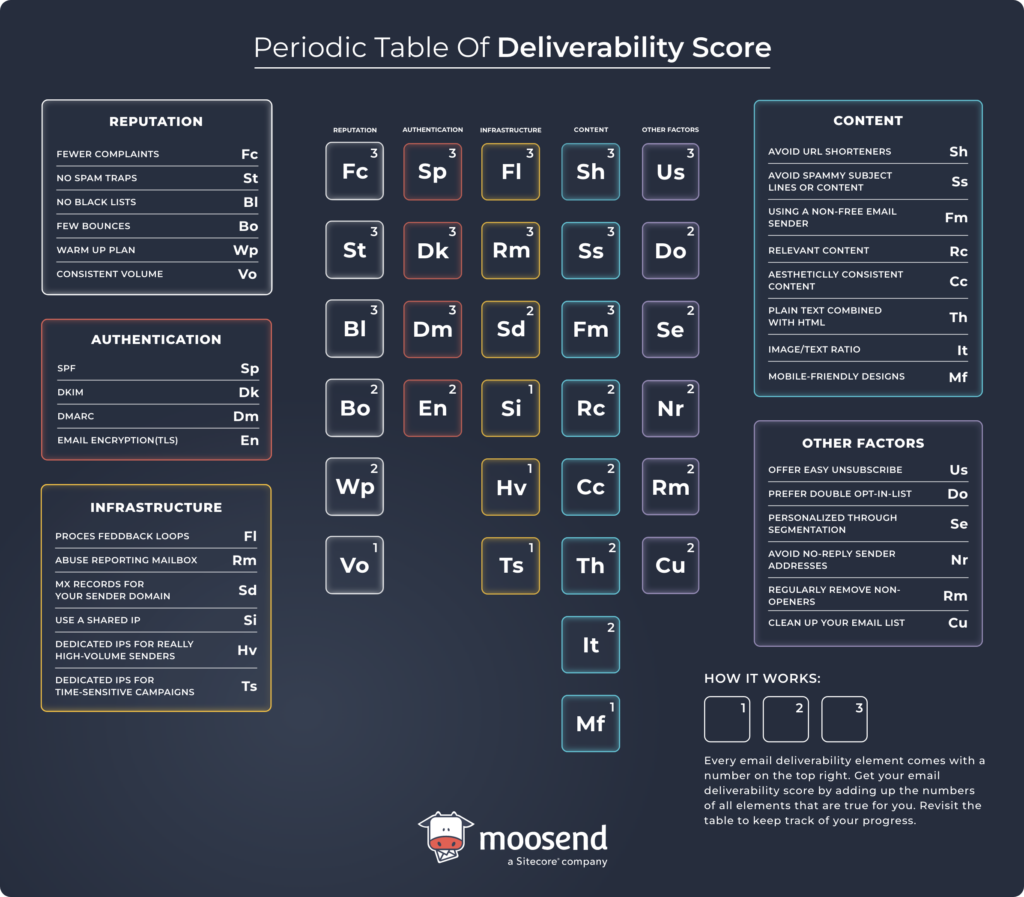
Discover how you could improve your open rates and keep your reputation as a sender intact. Follow the formula below to calculate the open rate of your campaign:
Open rate = Emails opened / (Emails sent – Emails bounced)
It’s important to know your open rate to evaluate how well or how poorly your email campaign is working. Also, it will help you see how your recipients view your subject line. If you believe your subject line is flawless, a low open rate may reveal a more serious issue: your email was sent to spam or blacklisted.
It will only take a minute!
How Email Reputation Impacts Email Deliverability
When you send an email campaign, mailbox providers run an initial set of vetting checks.
These are known as email reputation checks. Email reputation checks are complex formulas that all go together to generate a score. Based on that score, your email deliverability is affected. Although a confusing metric, we do know a few factors that are taken into consideration when generating that score:
- Who and How you are emailing
- The content of your email
- The frequency of emails
And they are a bit like credit checks for email, affected by:
- Sender reputation
- Server / IP reputation
- Domain reputation
- Email engagement metrics
Reputation checks are one of the most essential factors of inbox placement.
So you should always use an email testing tool to see what is going on.
You may also want to use an email warming service like Warmup Inbox to automatically increase your email deliverability and domain reputation while decreasing the likelihood of your domain being marked as spam or listed on a blacklist.
Disclaimer: Before using any email warm-up service consult with your email service provider if that’s an option!
With a live performance tracker, you’ll be able to keep track of the health and ongoing progress of your inbox, which is critical to maintaining high deliverability rates.
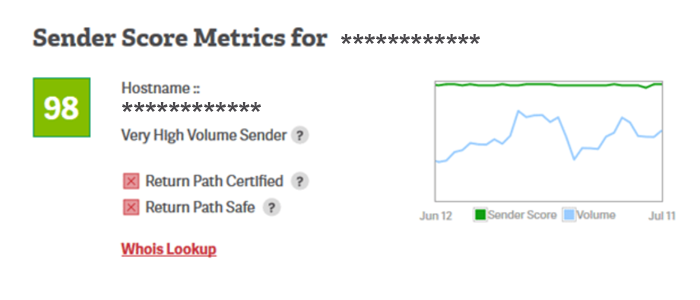
A bad reputation will see your inbox placement and open rates tank, resulting in all of your hard work going down the drain.
Let’s look at all the factors that are bound to email delivery reputation. We’ll start with your sender’s reputation.
What is Sender Reputation?
Sender reputation is the reputation of the email address you are using to send out your email campaigns.
Usually, your sender reputation is calculated on a scale of 0 to 100 to give you your sender score.
But how exactly does sender reputation work? What factors increase or decrease your sender reputation?
The short answer:
- The amount of mail sent from your domain
- The amount of mail sent from your IP address
- The volume of mail sent on a daily basis
- The volume of mail sent on a lifetime basis
If you have a large volume of mail going out each day, ISPs and ESPs may flag you as spam. Always remember: high sending volume to previously uncontacted addresses may get you called the “S” word (spammer) and land you on a blocklist; two things we want to avoid at all costs! It’s important to be careful when it comes to the volume and frequency of sending.
Email deliverability goes hand in hand with sender reputation. Here are five factors positively influencing sender reputation: consistent volume of email campaigns per week, few bounces, fewer complaints, no spam traps, no blacklists.
Let’s explore them one by one.
1. Be Consistent with Your Volume
Try to distribute your email marketing campaigns evenly.
A consistent volume of email campaigns, without major drops or spikes, plays a significant role in sender reputation.
For example, if you send out an email to your list twice a week, switching to three times a week will cause ripples.

There will be times when you will want to send out more emails than usual. For example, over the busy Christmas period. But aim for a regular, consistent schedule where possible.
Your list will soon get to know your schedule, which will help you increase open rates and click-throughs.
2. Keep Your Lists Clean to Crush Bounce Rate
Clean your lists.
At Moosend, we use ExactVerify, Email List Verify, NeverBounce, Data Validation, among others. Some other notable alternatives are
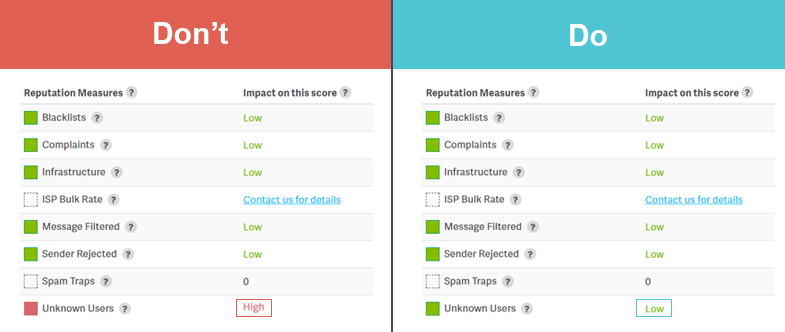
Bounces are emails that fail to reach the subscriber. If you receive a bounced email, immediately delete that contact from your list. Notwithstanding their impact on future email deliverability, they are a waste of resources. While we’re on the topic, there are two types of bounces you should be aware of; soft and hard bounce.
What is Hard Bounce?
A hard bounce happens when you send a message to a mailbox that doesn’t exist. Perhaps someone used a fake email to sign up to your subscriber list, or changed email providers. Either way, you don’t want those email addresses on your list.
What is Soft Bounce?
A soft bounce is an email that could not be delivered to its recipient’s mailbox due to temporary reasons. This means that while the current email message failed to reach the recipient, you might be able to make a successful email delivery at a later date.
A soft bounce occurs when:
- You email recipients with an auto-reply / out-of-office message
- Mail server settings block your email
- Send too many emails in the recipient’s inbox
- The mail server is physically down.
3. Spam Complaints = Death for Your List
A spam complaint is your worst nightmare when it comes to maintaining your email reputation and keeping positive email deliverability.
Subscribers should never be marking your newsletters as spam. If this happens, you need to take a serious look at what you’re sending out. Keeping the content of your newsletter relevant to what the customer subscribed to while avoiding spam-like activity is crucial.
When your subscribers hit the dreaded “Mark as spam” button, mailbox providers like Gmail and ESPs like Moosend receive a notification. The bad news?
Your domain reputation will be significantly damaged. Mailbox providers automatically block senders, even if it’s a small margin of complaints. It’s for this reason that we strongly discourage the use of purchased lists as they will see your spam complaints rocket.
4. Steer Clear οf Spam Traps
What’s a spam trap?
It’s a fake email address that looks real, but it isn’t. Spam traps are set by Internet Service Providers (ISPs) and blacklist providers to catch unscrupulous email marketers who have been harvesting emails.

They’re like honeypots that are published in a hidden location on the web. When spammers collect email addresses through harvester programs or purchased email lists, these fake email addresses often make it onto their lists.
Sending even a tiny amount of emails to those email addresses automatically marks the sender as a spammer. It’s clear that they built their list unnaturally.
5. Whatever You Do, Don’t Get Blacklisted!
If you’ve never heard of a blacklist, consider yourself lucky. Blacklists are online databases that store email addresses that have been reported as spam. Mail servers reference blacklists when they are determining whether or not to accept a message coming from a previously uncontacted domain.
The main reason for blacklists is to benefit most people on the internet, besides spammers. Blacklists are the bouncers at the club entrance, checking their list to see if you can enter or not. If you’re worried about landing on a blacklist, I would suggest avoiding high bounce rates, emailing mass amounts of people running the risk of being marked as spam, and having low engagement.
There are over 100 blacklists for different purposes, and you need to stay off of every single one of them.
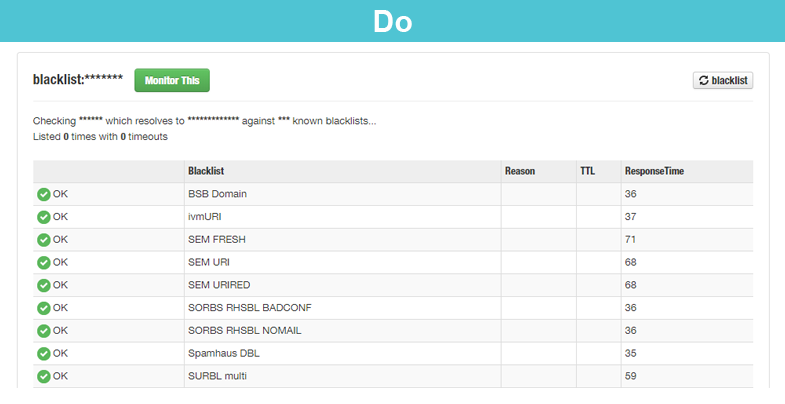
What Gets You Blacklisted?
Falling foul of any of points 1-4 above.
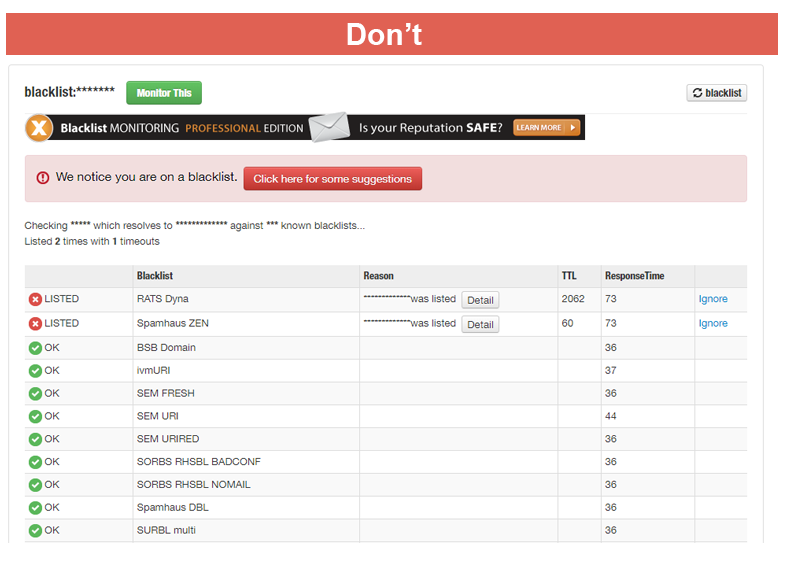
The good news is that if you get blacklisted once, there’s a strong chance you will be able to de-list your site/server. Repeat offenders, though, will have more trouble getting off the blacklist. To avoid that, Moosend continuously monitors blacklists to keep users safe.
You can use various email deliverability tools like MX toolbox and QuickMail to check if your server or domain is blacklisted.
Why Authentication (DKIM, SPF, TLS) Is Critical To Email Deliverability
As you’ve probably gathered by now, email deliverability is a complex topic. But it’s also an evolving one. Spammers are always looking for new loopholes and tricks. New ways to abuse your email inbox.
On the flip side, mailbox providers like Gmail are catching up in keeping spam messages low, or out of sight altogether. But now, let’s look at a tactic that has been used by spammers for years: email sender spoofing.
How Spammers Use Email Sender Spoofing
Sending an email on behalf of someone like [email protected] is easy. Change a few header values, and the ISP will think that Mark is trying to send out a message.
A typical spoofed email will look like this:
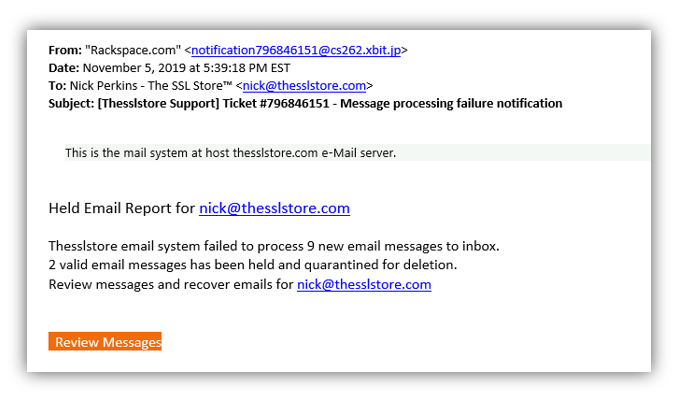
In the above example, it’s clear that the sender isn’t Rackspace, but the way the email is designed makes it seem legitimate. With email spoofing, spammers can easily impersonate your brand’s email and send campaigns on your behalf. Right?
Well, fortunately, it’s not quite as simple as that. And mailbox providers are getting better at catching this type of spam. Most providers – certainly all major ones – will perform an ID check when receiving a new email.
Here’s How It Works
A mailbox provider receives an email from an address (say [email protected]).
- The provider checks the IP address where the message originated.
- Then, they check to see if that IP address has permission to send emails on behalf of yourdomain.com.
This is called authentication. But let’s clarify something: Sending emails on behalf of another address is not necessarily a bad thing. Why?
Because this is precisely what all email service providers (ESPs) such as Moosend do to deliver the campaigns you design and send. After all, you want to be sending emails from your branded domain.
Setting up authentication in your email marketing service of choice is highly recommended. It will hint to Hotmail or Gmail, and all other providers that you have given consent to send emails on your behalf.
There are two main ways to set up email authentication: SPF and DKIM. Let’s take a look at them.
6. Use SPF To Verify Your Sender IP
Setting up your SPF records is essential. On Moosend, it is intuitive, too.
SPF (Sender Policy Framework) is an email validation system designed to prevent spam by verifying the sender’s IP address.
SPF is also used to prevent spam artists from sending those spoofed messages on your domain’s behalf. It’s helpful to set up your SPF so email servers can verify and validate the authenticity of the email being sent. An SPF record allows web administrators to designate which web hosts are authorized to send messages from a given domain. So how does this work?
When an SPF record is added to your website’s DNS, servers use it to verify that you are allowed to send emails from [email protected]. Simply put, SPF says you are the owner of the domain and are allowed to contact people using this domain name.
SPF sends information to prove that the email is safe to be sent and received. This information is viewed and approved by the DNS records. If they are approved, the mail is delivered accordingly and in a timely manner. If they are blocked, the mail will be marked as “spam” and the message will not be delivered.
7. Use DKIM to Verify Ownership of an Email Message
DKIM (DomainKeys Identified Mail) indicates ownership of the email message by a particular organization. DKIM exists to stop all emails that have a suspicion of spam activity from being received by the email server.
While the message is still in transit to the recipient, the organization’s signature is added to the email headers. Most email clients will check for a valid DKIM signature on incoming emails to identify who sent it.
When DKIM is set up properly, all mail you send should have an encrypted, digital signature in the header section of the email. This ensures that the contents of the email have not been modified in transit and the email is sent from the correct domain.
This means DKIM is a working way to prevent email deliverability issues and increase your sender reputation with email services. The receiving mail server can identify the origin of the email marketing campaign.
Should You Use SPF or DKM?
Quick answer: You should use both.
DKIM works with both DMARC and SPF to secure all aspects of validating incoming mail. You should have all set up for the best results. Unless you are an email marketing nerd, you probably don’t need to know precisely how SPF and DKIM work.
But what you do need to know is that both authentication levers are required to reduce spam and improve email deliverability rates. SPF and DKIM work together.
For instance, DKIM alone does not guarantee that the sender’s server is permitted to send outgoing emails in the name of your website (your domain). Often, SPF on its own is powerless as many website owners research different web hosting services, then choose shared hosting. With shared hosting, multiple sites share the same IP address.
Where Are SPF and DKIM Records Located?
SPF/DKIM records are set in the “DNS settings” section of your domain name provider.
If you are wondering what DNS or Domain Name Service (or System) is, here’s a useful analogy. Think of DNS as a phone book for the Internet. It translates human-friendly computer hostnames into IP addresses.
To make the authentication process easier for you, we have put together a list of Help Articles. Find out more on how to set up SPF/DKIM, depending on where you have registered your domain name.
How Do You Set Up SPF / DKIM on Moosend’s Platform?
Moosenders can easily set up SPF/DKIM authentication by following the steps described in these Help Articles:
Alternatively, you can watch a short step-by-step video guide prepared by our team.
You’ll learn exactly where SPF / DKIM settings are located in your Moosend account. And you will also find out more about how to go through the authentication process correctly.
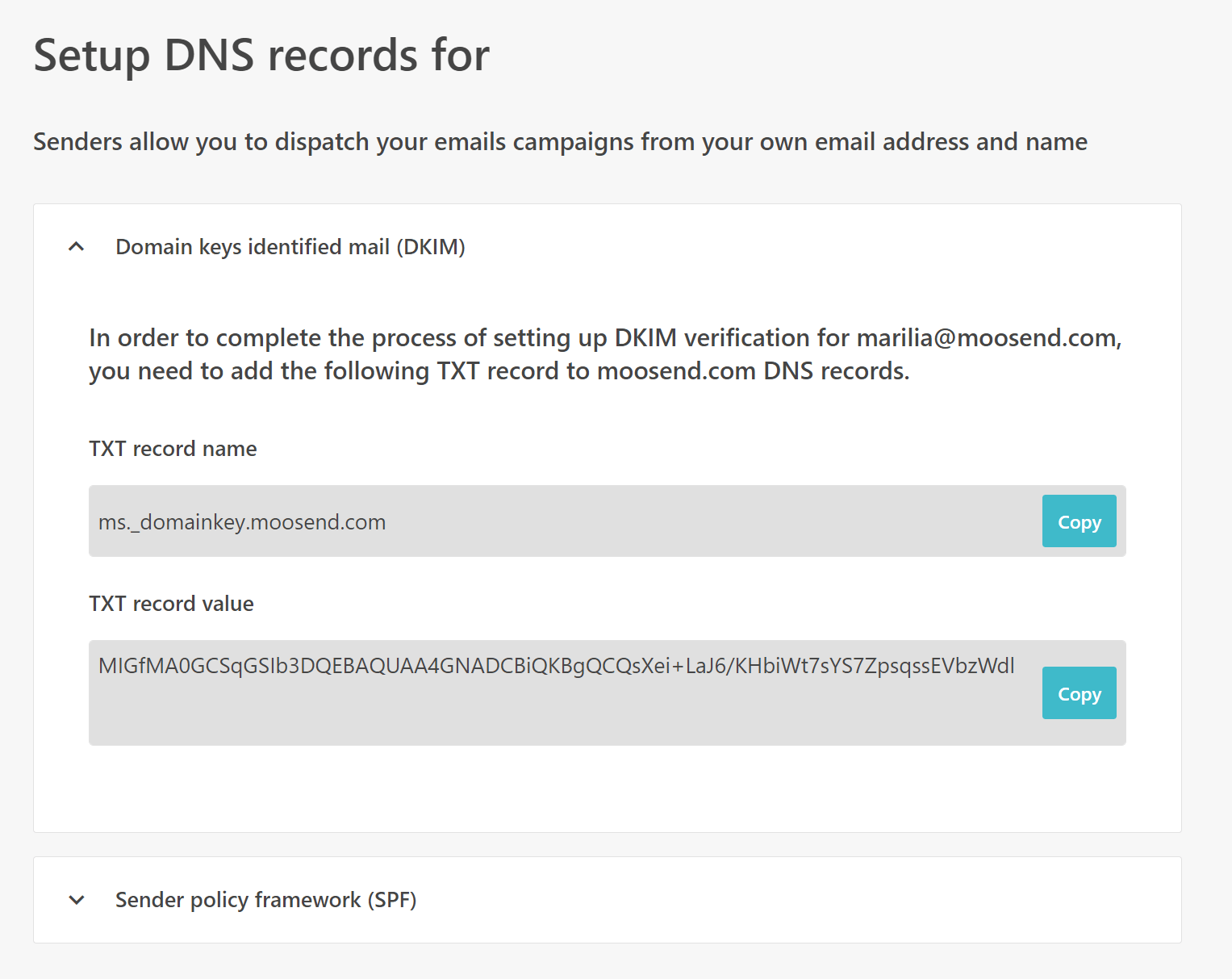
The good news? It’s super easy. In fact, it will only take a couple of minutes to set everything up.
And once everything is in place, you should see an increase in the delivery rate of your campaigns. But if you’re struggling, don’t worry. Our friendly Moosend support team can answer any questions you might have via live chat.
Find out more about Moosend’s email deliverability rate here.
Will SPF/DKIM Guarantee That You Pass Anti-Spam Checks?
SPF / DKIM authentication is not a magic bullet for passing spam filters. It’s an essential step in the process of increasing email deliverability. But, inbox placement cannot be guaranteed by SPF / DKIM alone.
Need a more thorough explanation of why some emails reach the inbox, while others are marked as potential spam or junk? Read our SPF / DKIM articles and follow these best practices to increase your sender reputation.
How Can You Check That SPF / DKIM Are Properly Configured?
If you have updated DNS records correctly and SPF/DKIM authentication is not working right away, you might need to wait up to 24 hours. Why?
Because it can take time for servers to read the change in your DNS records. If you are still experiencing problems, you will need to contact your domain provider for tips on troubleshooting DNS records in their “DNS settings.”
8. Encrypt Your Email with TLS to Build Trust with Users and Mailbox Providers
By its nature, email is prone to information disclosure. Since most emails are transmitted in an unencrypted form, TLS is essential.
Quick note: Moosend enables quick TLS setup – you no longer have to worry about service penalties!
So what is TLS?
TLS is a form of encryption for email messages which protects the content from being read by entities other than the intended recipients. Email encryption may also be considered as a form of authentication.
Gmail implements TLS for email delivery, but at the moment, it’s still an optional requirement. And there is still no proof that unencrypted emails fail inbox placement on Gmail or other providers.
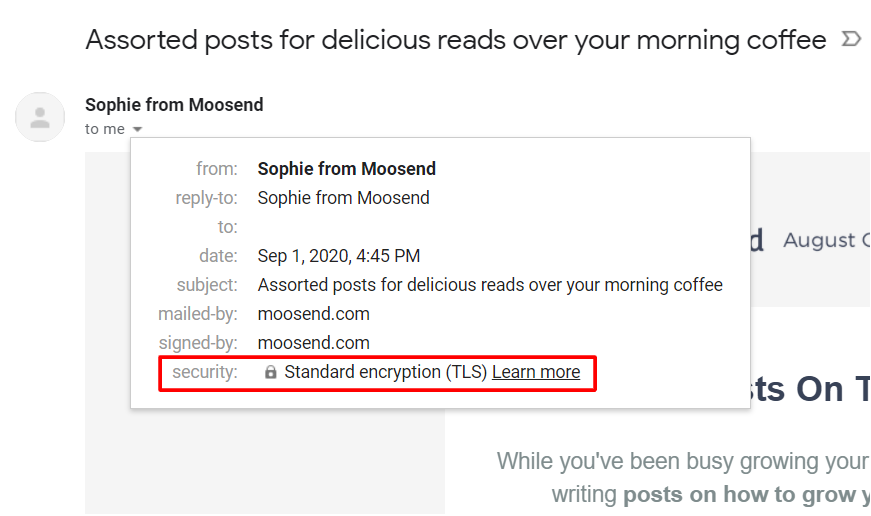
Nevertheless, we believe that the TLS requirement will eventually become mandatory. For the time being, TLS-enabled emails will show a nice padlock icon on Gmail to notify your customers that your emails are encrypted.
Encrypt Your Email with a Third Party
Email encryption is a surefire way to ensure the deliverability and security of your emails. But sometimes, knowing how to do this and complying with all the which go along with it can be tricky to navigate.
While many email marketing software providers have an encryption feature in-built, if you’re sending emails via other methods, including Gmail and Outlook, a third-party provider, such as Virtru, might be the solution to your problems.
Doing this will not only help in your email deliverability but several other email-related issues too. You can prevent third-party access to your data, maintain control over sensitive data, and audit access to emails and attachments, just to name a few!
How Infrastructure Impacts Email Deliverability
Email deliverability infrastructure is the software and hardware used to deliver your emails to your recipients. The infrastructure required to send emails at scale is not to be taken lightly.
Skipping this step to jump into email outreach can be detrimental to your campaign and brand. Setting up your own infrastructure rather than using an ESP such as Moosend is very complex and cost-inefficient.
Setting up your own infrastructure rather than using an ESP such as Moosend is very complex and cost-inefficient. There are several low-level protocols and standards that you must implement and adhere to. And you will quickly find that you need very specialized personnel to handle the operation.
Frankly, it just isn’t worth the hassle. And we strongly suggest that you use a service such as Moosend to handle tasks and focus on your core business. So what exactly affects email deliverability from an infrastructure standpoint?
The IP Address (Dedicated vs. Shared)
There are two types of IP addresses that relate to email deliverability.
Dedicated IPs, which are a best practice for high volume senders, and shared IPs.
So which do you need?
9. High Volume Sender? – Opt for a Dedicated IP Address
Dedicated IPs are exclusively used for your campaigns and senders. Email programs based on dedicated IPs flourish on consistent, healthy volume.
Inconsistent volume, with dips and spikes, from a dedicated IP, will be counterproductive and will classify you as a spammer.
A dedicated IP is when only one person uses the IP address. A dedicated IP provider will assign a unique IP Address to the user and keep it separate from the local IP.
Users with a dedicated IP will always be using that IP Address regardless of location or purpose. Keep in mind, dedicated IPs come at a cost while shared IPs are free of charge.
10. Time-Sensitive Campaigns? – You Need a Dedicated IP Address
Dedicated IPs are used exclusively for your own campaigns. There are no noisy neighbors or throttling because of issues caused by other senders.

It’s a direct connection to the ISP and lightning-fast at delivering your messages over to your recipients. If there is any time sensitivity in your campaigns, we recommend that you opt for a dedicated IP.
Can I Get a Dedicated IP Address For Sending Emails At Moosend?
At Moosend, we offer dedicated IPs to high-volume senders. In fact, you don’t even have to worry about this.
We monitor your email marketing program and will switch you to a dedicated IP if we think it will benefit you and your subscribers. But we also evaluate explicit requests for dedicated IPs as they are a scarce resource regionally and globally.
Additionally, requests for dedicated IPs often come from hardcore spammers. So all requests are vetted manually by our deliverability team.
11. Shared IPs for Everyone Else
Get a shared IP pool with Moosend – the ESP that has your back.
If you send fewer than 200-300,000 emails per campaign, then you don’t need a dedicated IP. Your email marketing account would benefit more from using a shared pool of IP addresses.
Shared IPs are only available in Email Service Providers such as Moosend. You can’t create a shared pool of IP addresses for your own email marketing program.
Also, if you have concerns about your email list hygiene or the quality of your mailing list, you will be better served using a shared pool of IPs. They will help you get a lift on your email deliverability and combat delivery issues if you are below average on the IP pool.
At Moosend, we have a range of shared IP pools that we assign to clients automatically based on:
- their overall quality score
- the engagement of their subscribers
- the industry they operate in
If you’re interested, don’t hesitate to sign up for a free account first, test Moosend’s email deliverability and, if satisfied, join one of our paid plans starting at $9/month.
12. Monitor Mailbox Provider Feedback Loops
You must process feedback loops regularly – Moosend does this for you consistently!
Most major mailbox providers operate a feedback loop service to report back complaints to email service providers such as Moosend. When one of your subscribers hits the “Mark as spam” button, a request makes it back to the ESP through the feedback loop.
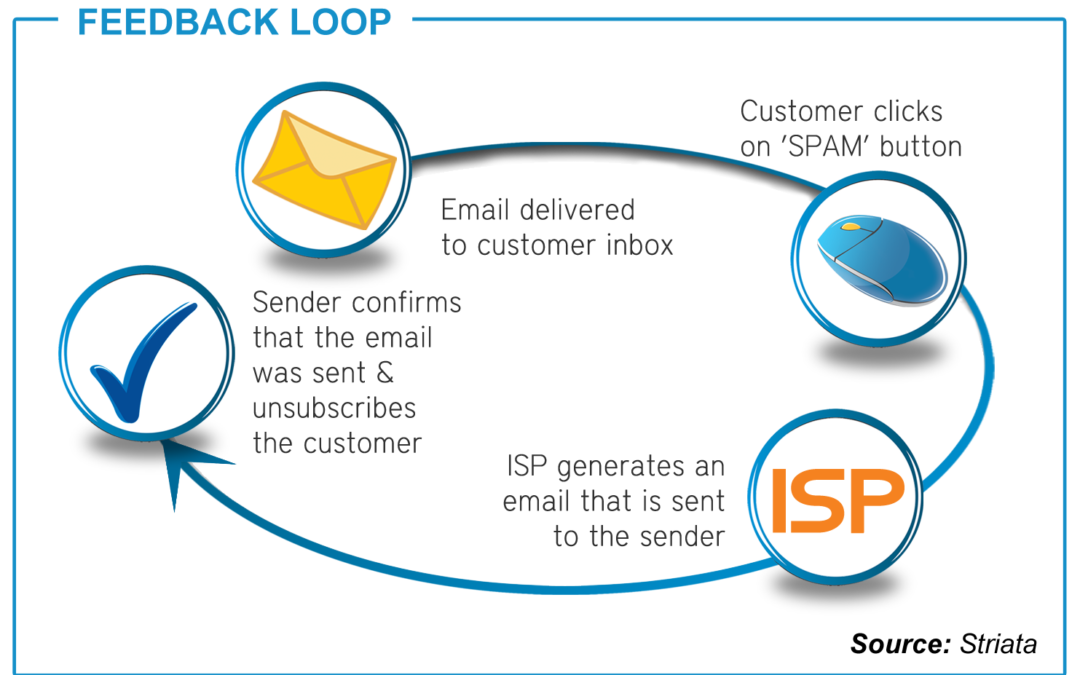
It’s imperative to unsubscribe and remove customers who complained from your mailing list immediately.
The only way to do that is through monitoring various mailbox provider feedback loops. At the time of writing, there are more than 20 significant providers offering feedback loops. So implementation is not straightforward.
Fortunately, Moosend automatically registers all customers, senders, and campaigns with feedback loops. We then report back on complaints received.
So, the hard part is over! Some feedback loops, like the one offered by Gmail, are only available to exclusive members of M3AAWG (Messaging, Malware, and Mobile Anti-Abuse Working Group).
The good news?
Moosend is a member of M3AAWG and implements the Gmail feedback loop for your campaigns.
13. Set up (and Monitor) an Abuse Reporting Mailbox
Some mailbox providers require email campaigns that land in their users’ inbox to operate an abuse-reporting mailbox. What is it? An email address to forward abuse complaints to.
To ensure email deliverability, it’s vital that you have an abuse reporting mailbox setup and monitor it frequently. You can implement it through the use of an email header.
Many mailbox providers without feedback loops will forward complaints to those mailboxes instead.
14. Set Up MX Records for Your Sender Domain
You need to have a valid MX record set up for your sender domain. Why?
Because otherwise, some ISPs will automatically block your email.
You may have heard MX records referred to as a DNS “mail exchange”. In short, an MX record directs emails to a mail server. The MX record navigates the mail following the rules of the SMTP (Simple Mail Transfer Protocol).
How Content Affects Email Deliverability
It might sound weird to you, but your email content is one of the factors affecting your deliverability. Poor content, bad designs, and unresponsive newsletter templates can break your deliverability.
Email service providers, internet service providers, and spam filters all look for the same characteristics when determining if a message is safe or not.
The first characteristic is the language used in the message you are attempting to send. Using negative or spam trigger words can send your message right into the spam folder, so be careful!
Another characteristic is the use of links in the message. A dangerous link can send red flags flying when spam filters, ISPs, and ESPs get a hold of it. For a good rule of thumb, keep the links to a maximum of one.
Lastly, ISPs, ESPs, and spam filters look at the content of your email in terms of length.
We have found most success at 500 characters. Any longer may trigger a red flag and too short of a message can also send your email to spam.
So, what can you do to avoid delivery issues and boost your reputation?
15. Send Relevant Content That Your Subscribers Want to Read
Will your subscribers actually benefit from your email campaign?
Think before you send it! It doesn’t get simpler than that. Ask yourself – do my subscribers expect this type of content?
Do your subscribers expect offers about laptops, but you send them the latest movie blockbuster? Chances are that they will end up unsubscribing. Or, even worse, reporting you.
Personalization and preference centers help with this. But it all comes down to sending content that is familiar to your subscribers.
16. Looks Matter: Be Consistent with Your Design
Let’s see an example from the shoe giant, Nike:
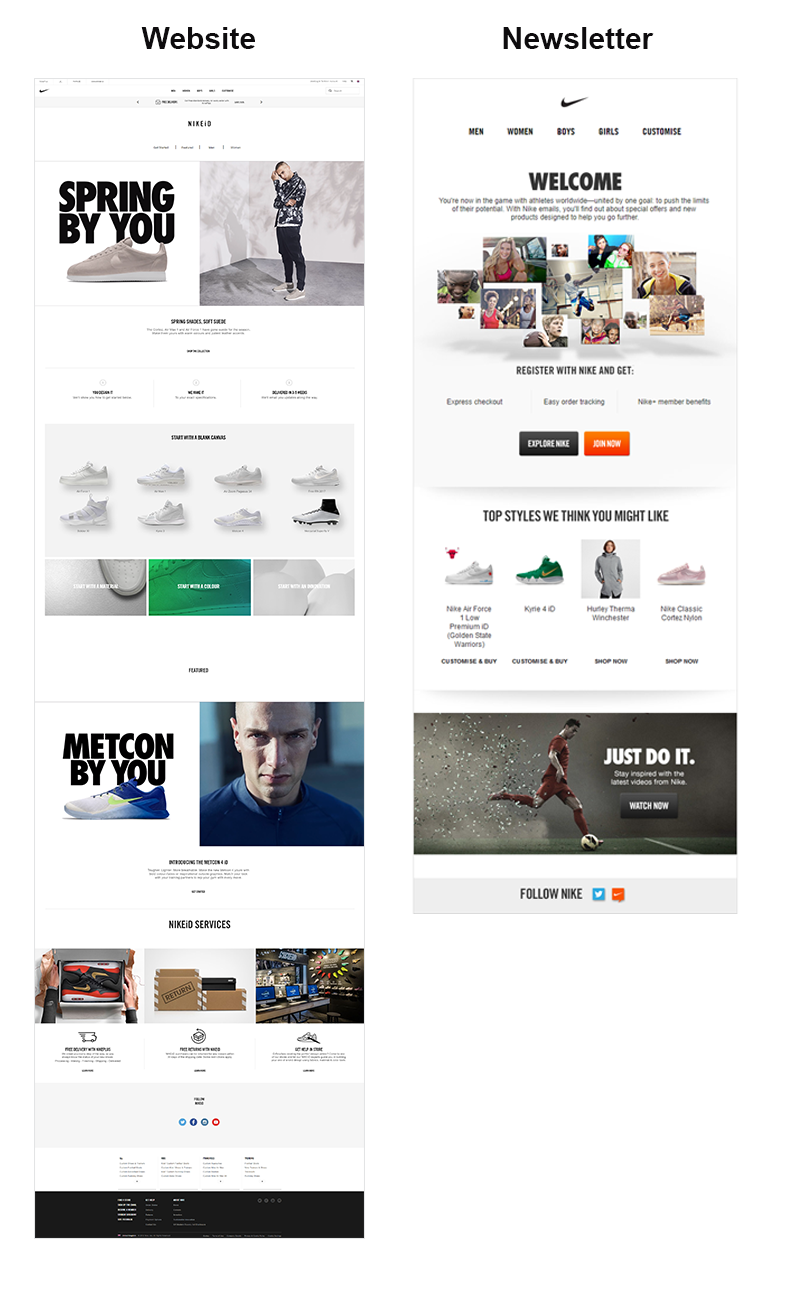
We don’t need to tell you how important branding is to marketing. Your website and other marketing materials will have a consistent look. Your email campaigns should be the same.
It’s vital to maintain brand consistency throughout your newsletters. If your designs are all over the place, you run the risk of your customer not recognizing your email. When a customer does not recognize your brand in an email, they may mark you as spam.
Your subscribers are familiar with your brand identity. They won’t expect massive design changes between campaigns.
Of course, while your newsletter images will attract attention, don’t forget to invest in an equally attractive email copy to keep your email subscribers engaged.
17. Mobile-Friendly Designs Are No Longer Optional
Did you know that almost 50% of email opens now occur on mobile devices?
This means there’s no excuse for sending campaigns that look great on a desktop or web client but suck on mobile.
In fact, there is a correlation between the complaint rate (or spam-iness) of your campaign and the absence of mobile compatibility. A campaign that looks out of place on mobile devices will disengage subscribers.
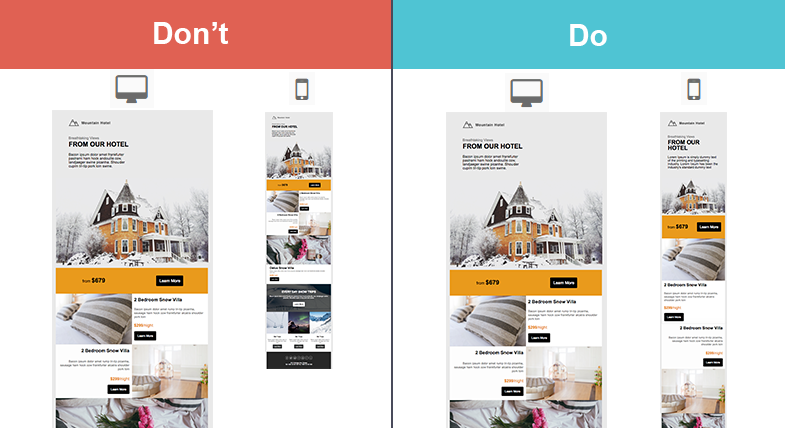
And in some cases, it can lead them to unsubscribe since they cannot use their preferred mobile email client to read your brand’s newsletters.
So make sure your campaigns are mobile-friendly, have the right newsletter images, and copy to avoid falling into one of the most common pitfalls of email deliverability.
18. Be Careful with URL Shorteners
URL shorteners are those handy little tools that take a long URL and convert it into a short version.
For example, they may take:
https://academy.moosend.com/courses/set-your-moosend-in-motion-for-all-businesses/ and convert it to: https://bit.ly/2ZnTRn1.
They are useful for cutting down the length of your URLs, but they are also good at masking where a link goes.
For instance, the shortened link above does not indicate its final destination. This is why spammers commonly use link shorteners.
They want to hide their malicious websites and blocked domains from users and mailbox providers. Major link shorteners are public services and, therefore, nothing stops spammers from using them to mask their URLs.
We strongly advise against using these services as part of your email marketing routine.
Link shorteners have benefits, but they are outweighed by the shortcomings related to email deliverability. If you must use link shortening as part of your email campaigns, we recommend implementing your own.
Alternatively, you can set up a tool like YOURLS, Phurl, and Rebrandly’s URL Shortener.
19. Don’t Use Spammy Subject Lines or Content
Your subject line is the only thing your subscribers read before opening your email campaign. It has also been proven that mailbox providers, such as Gmail, “read” your subject lines and content and decide whether it contains spammy keywords or not.
This is another important factor when it comes to email deliverability and ties back into content. Be very careful with the subject lines to avoid being tossed into the spam folder before your customers see your email.
We’ll be honest here.
No one knows the exact implementation of Gmail or Outlook’s algorithm for classifying messages as spam. But a good start would be to avoid any spammy terms such as those listed here.
CAPITALS and misleading prefixes (such as RE: or FW:) also trigger spam filters.
Why start your subject with’RE:’, anyways, when you can get so much more creative?
Bonus Subject Line Tool: Get free access to Refine, our brand new subject line tester, which predicts the open rate of your subject lines over the industry average!
20. Don’t Use Free, Personal Email Addresses for Your Campaigns
Your campaigns must fully represent your brand.
So there’s no point sending emails from your personal Gmail address. The reason is simple:
A Gmail address is a personal email address. This means your email campaign will most likely be considered spam by the various filters used by email service providers.
Ergo, it will not be delivered. So use a professional email address from a domain name recognized by your recipients.
From a technical standpoint, Gmail and other ISPs implement an extra layer of authentication called DMARC (Domain-based Message Authentication, Reporting & Conformance).
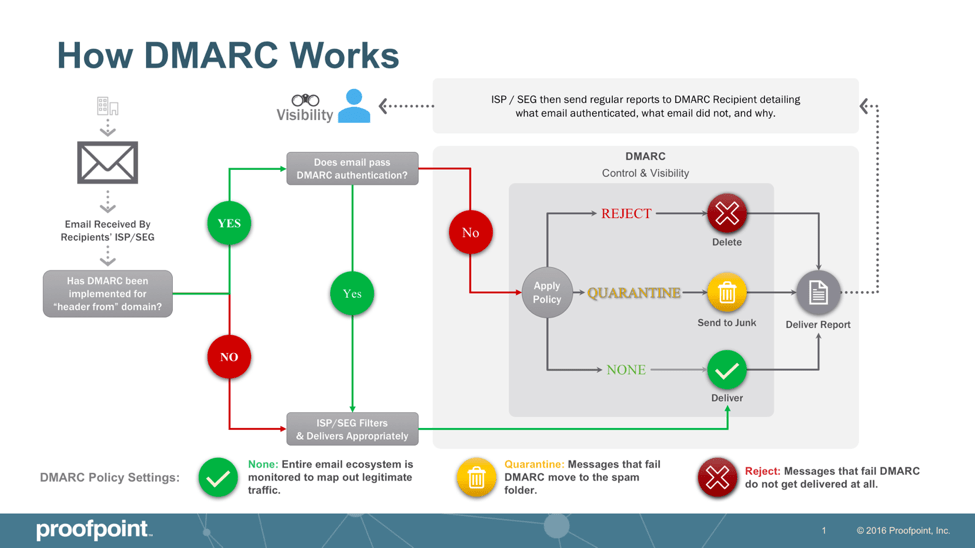
The popular email provider changed its policy a few years back and decided to penalize emails sent from Gmail addresses outside of Gmail. The reason email providers adopt it is that it provides an additional safety measure.
In fact, there are still instances where SPF and DKIM checks are not enough to ensure the recipient’s safety. DMARC adds an extra level of cryptography. To ensure your DMARC is set properly, you can use Moosend’s DMARC Checker tool.
21. Always Include a Plain-Text Version Along with Your HTML Campaign Version
Plain-text campaigns! Sent no-one ever…
An email campaign without visuals is usually dull, right?
But what if I told you that it is, in fact, one of the best ways to increase your email deliverability? Email clients are smart.
They will display the most compatible version of your email campaign based on your subscribers’ settings.
While not fancy, this is a good practice for email deliverability purposes.
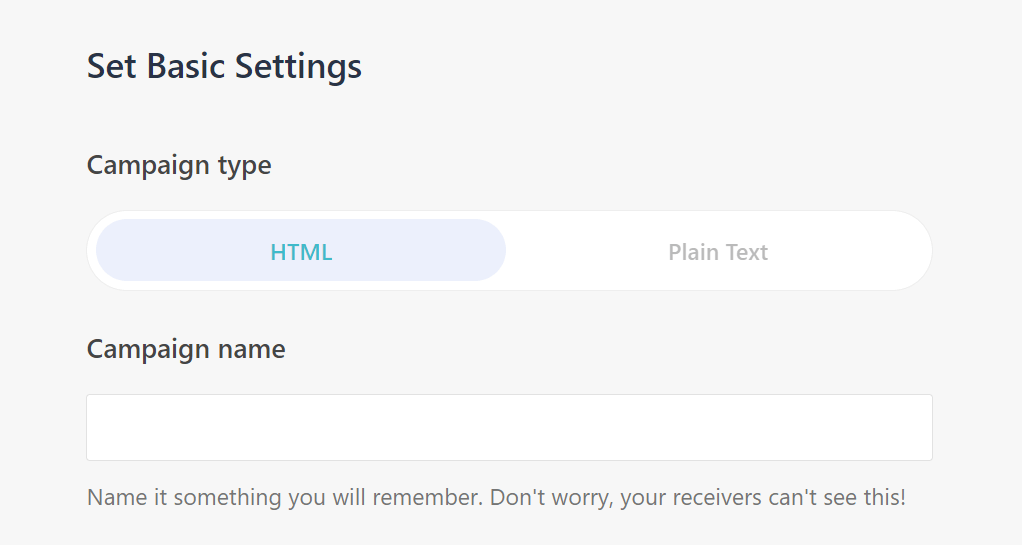
And as you can see above, when you sign up for a Moosend account, you get the option to create a plain-text version of your campaign.
Plain-text works because all recipients will be able to see your message. That’s a win for your deliverability!
22. Pay Attention to Image/Text Ratio (But Don’t Sweat It Too Much)
We’ll be honest. Nowadays, the image-to-text ratio plays a less critical role in the spam filters of major inbox providers.
But to maximize email deliverability, it’s still something you should be aware of.
Spam Assassin recommends a minimum of 60% text and a maximum of 40% images in your email campaigns.
Our tests and those in the industry concluded that there is less of an issue with the image/text ratio when other factors are satisfactory.
Other Factors Affecting Email Deliverability
Email deliverability is a complicated matter affected by numerous factors you might haven’t even thought about.
Here are some additional points you need to consider, no matter what. Let’s see.
23. Use Double (Rather Than Single) Opt-In for Your Lists
Opt-in is the explicit permission of a customer, or intended recipient of an email, to allow a marketing team to send messages with promotional information about their brand.
There are two common forms; single opt-in and double opt-in. Let’s take a look at them.
What is Single Opt-in?
As the name suggests, this process requires only a single action to turn a visitor into a new subscriber.
What is Double Opt-in?
An email address is added by any means to a mailing list. A confirmation email is sent to verify that the person the email belongs to consents to receiving messages. This is generally done by clicking a confirmation link. On occasion, consent can also be given externally, even offline.
So, double opt-in registration is when confirmed consent of an email’s owner to receive messages is requested.
24. Segment to Give Your Subscribers EXACTLY What They Want
A significant factor in email deliverability is sending relevant content that your subscribers want to read. Unfortunately, this is not always possible for big brands with large mailing lists. The solution is to use segmentation to create subsets of your mailing list with common interests.
For example, you could send different campaigns to those interested in electronics vs. those interested in buying sporting gear. The good news is that personalization techniques have really improved over the past few years.
Automated sendings such as cart abandonment notifications and algorithmic product recommendations are achievable for every marketer. Moosend offers a wide range of segmentation and automation option as part of our powerful marketing automation feature.
We highly recommended that you make use of them and send the right message at the right time.
25. Make It Easy to Unsubscribe (Seriously)
This might sound a little counterintuitive.
But you want to make it super easy for your list members to unsubscribe.

Here’s why: Hiding your unsubscribe links using various font sizes and color techniques only make your subscribers lose patience and trust. Worse still, they could mark your email as spam instead of unsubscribing.
The industry standard for complaints is 0.1%. This means that sending a campaign to 10,000 subscribers gives you only ten tickets to the “Mark as spam” button. Any more than that, and your campaign is over the threshold. Which will put your sender reputation in jeopardy.
A footer offering a no-tricks unsubscribe link is a great way to keep your complaint rate low and maintain a high inbox placement.
A little background on this…
The CAN-SPAM Act of 2003 created federal protocols that must be followed when emailing in the United States of America. This was set forth to protect consumers from spammers, phishing emails, and other unsolicited emails. There are certain rules and regulations that must be followed when sending out promotional emails with the intent to sell. To avoid violating the CAN-SPAM Act, be sure to give your customers the option to “opt-out.”
Moosend adheres closely to popular anti-spam regulation. We automatically add an unsubscribe link to every email sent using our platform. We cannot overstate the importance of making your unsubscribe links obvious.
26. Don’t Use a “No-Reply” Sender Address

“Do not reply” email addresses look like “[email protected]” and serve as a black hole for incoming mail.
Marketers often send their campaigns from such do-not-reply email senders. It happens. But, more importantly, it happens A LOT.
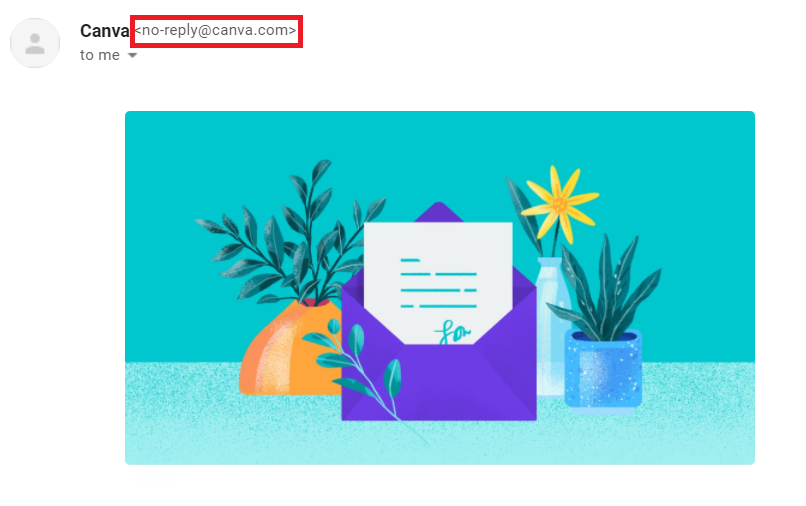
These email addresses give the wrong idea to your users. Why should they not reply? Don’t you want to hear from them?
There is more than one reason to avoid no-reply addresses. But above all, it makes you look unprofessional and unapproachable.
It also massively affects your email deliverability and open rates. And trust me, you don’t want that!
Over To You
Follow the steps in this guide to maximize the deliverability of your emails. Your engagement stats will skyrocket.
If you have any questions or comments, then please leave them below.
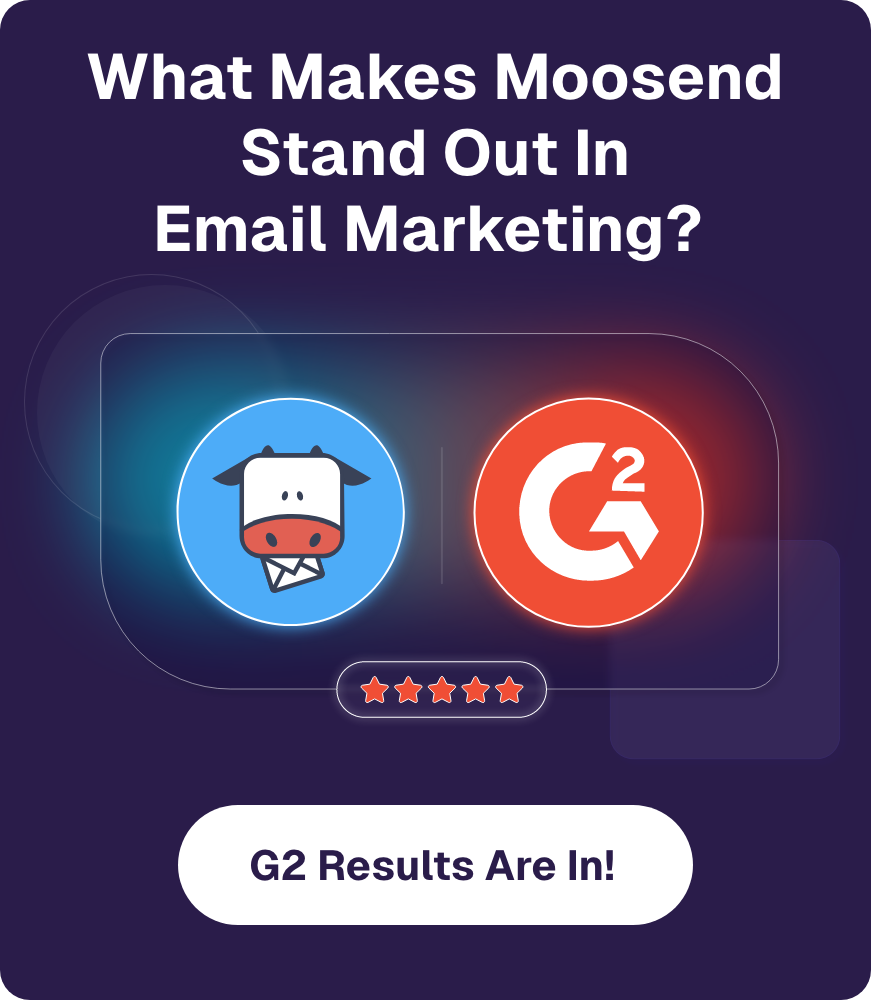



 Published by
Published by
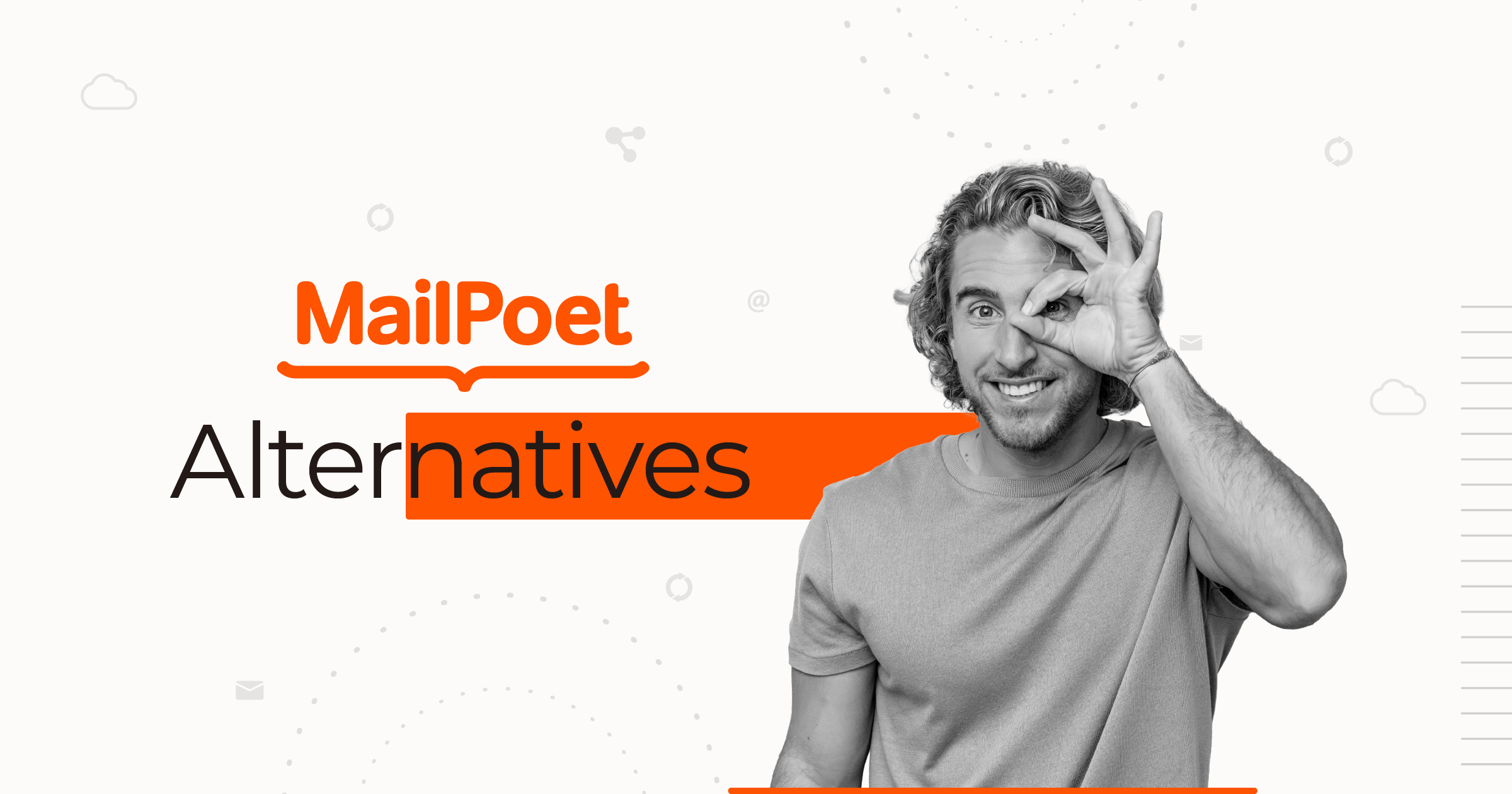
 Published by
Published by
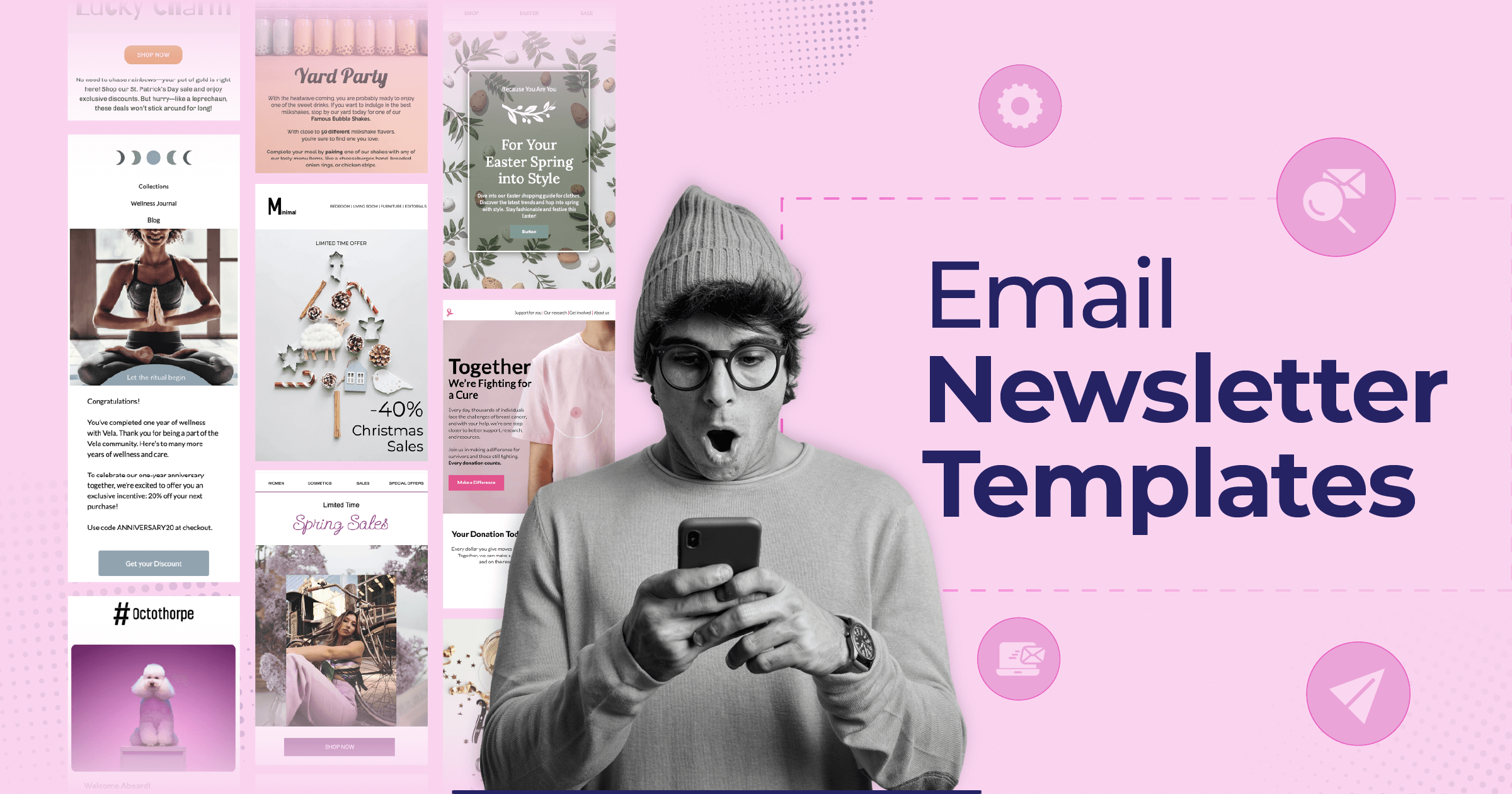
 Published by
Published by